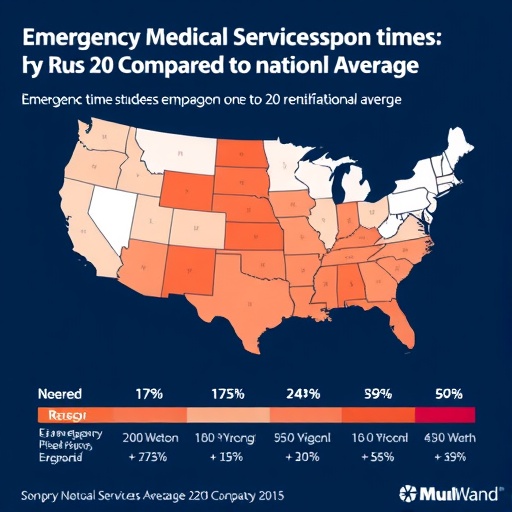Emergency Medical Services in Rural America Face Significant Delays and Higher Patient Acuity, New Study Reveals
A recent comprehensive analysis of emergency medical services (EMS) in rural America has uncovered stark disparities in response times and patient severity compared to the national average. This large-scale study, analyzing over 4.8 million rural EMS calls against a national dataset encompassing 64.6 million calls from January 2023 through January 2025, reveals that patients in rural areas endure considerably longer waits for emergency care while presenting with more complex, life-threatening conditions. These findings shed light on systemic challenges faced by rural healthcare systems and may have profound implications for policy and resource allocation.
The investigation, led by Isabella Turcinovic, a third-year medical student at Baylor College of Medicine, was presented at the American College of Surgeons Clinical Congress 2025 in Chicago. The analysis disclosed that the average EMS call duration — combining scene response, on-site care, and transport to medical facilities — in rural regions stands at an alarming 92.8 minutes, markedly longer than the 74.1-minute national mean. This difference is even more pronounced for high-acuity patients, whose emergencies involve severe injuries or complex medical conditions requiring immediate, sophisticated care.
High-acuity cases compose roughly 39.3% of rural EMS activations, a substantial increase compared to 26.4% nationally. The study highlights that these critically ill or injured patients in rural areas face nearly 30 extra minutes waiting for prehospital care compared to similar urban and suburban cases. Further, when transported to specialized trauma centers equipped to manage severe injuries, rural patients’ EMS call times extend up to 155 minutes, compared with the national average of 114 minutes. These prolonged intervals can critically compromise patient outcomes due to delays in definitive treatment.
One striking revelation relates to the types of hospitals rural EMS patients are transported to. In rural America, patients are four times more likely to be taken to trauma centers designated for less severe injuries—facilities typically lacking the resources to manage complex trauma cases effectively. Additionally, transports to critical access hospitals, small rural medical centers providing essential but limited care, occur five times more frequently in these regions than elsewhere. These trends underscore the prominent role rural hospitals fulfill despite constrained capabilities.
Dr. Chad T. Wilson, associate professor of surgery at Baylor and senior author of the study, emphasized the disparities highlighted by these data. According to him, rural communities often struggle with inadequate infrastructure and resource bottlenecks that delay emergency response, magnifying risks for patients with critical medical needs. The necessity for bolstered support towards rural healthcare centers, especially in managing high-acuity emergencies, emerges as a direct implication of this research.
The underlying causes of heightened injury severity and delayed care in rural settings are multifactorial. Limited access to routine healthcare can exacerbate chronic health conditions, culminating in acute crises requiring EMS intervention. Furthermore, lifestyle and environmental factors prevalent in rural areas — including higher-risk occupations such as agriculture and industrial work, as well as hazardous commuting conditions characterized by long distances and higher speeds — contribute to increased incidence and severity of trauma.
The extended transport times to specialty care highlight logistical challenges in rural EMS deployment. Sparse geographic distribution of advanced trauma centers necessitates long travel distances, inadvertently prolonging patient exposure to potentially worsening conditions. Combined with extended on-scene times required to stabilize complex injuries, these factors compound delays that may determine morbidity and mortality in time-sensitive emergencies.
The study’s authors advocate for targeted policy actions to support rural EMS infrastructure, enhance training at critical access hospitals, and optimize resource allocation for expedited transfers to Level 1 and 2 trauma centers. Investment in telemedicine and remote diagnostic tools may also alleviate some challenges by enabling earlier intervention and triage decisions that can improve patient outcomes.
Future research led by this group intends to explore interventions that may bridge these care gaps. Understanding how to refine EMS response models, improve interfacility coordination, and leverage technology could transform rural emergency care paradigms and diminish outcome disparities identified in this analysis.
The study’s importance is amplified by ongoing concerns about funding and sustainability of rural hospitals. As essential providers for emergency and acute care in these communities, ensuring their capacity to manage increasing high-acuity cases is critical. This research provides empirical evidence to justify enhanced support and targeted innovations in rural emergency medical systems.
In conclusion, this large-scale study exposes a pressing healthcare inequity faced by millions of rural Americans — longer EMS response times paired with a higher burden of severe medical emergencies. Addressing this disparity requires concerted efforts spanning policy reform, system redesign, and community health investment. Such measures hold promise to improve the lives of vulnerable rural populations and elevate the standard of emergency medical care nationwide.
Subject of Research: Disparities in emergency medical services response times and patient acuity in rural versus national populations.
Article Title: Disparities in Timely Access to Prehospital Care in Rural America.
News Publication Date: October 3, 2025.
Web References:
– American College of Surgeons Clinical Congress 2025: https://www.facs.org/for-medical-professionals/conferences-and-meetings/clinical-congress-2025/
References:
– Khan L, et al. Disparities in Timely Access to Prehospital Care in Rural America. Scientific Forum, American College of Surgeons Clinical Congress 2025.
Keywords: Rural populations, Emergency medicine, EMS response times, High-acuity trauma, Critical access hospitals, Rural healthcare disparities, Prehospital care, Trauma centers, Healthcare access inequity





